January 2009 Archives
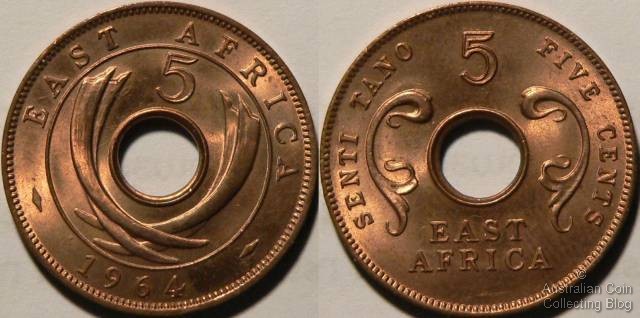
East African 5 cent - East Africa Ceased to Exist in 1964
A popular method of quickly building an interesting and diverse coin collection is by collecting using the 'one from every country' theme. In coin collecting circles if you collect with this method then you are abbreviated to being an OFEC collector. Put simply this just involves collecting one coin from every country. Of course like most other ways of collecting coins this leads to complications. What exactly defines a country and at what moment in time do you derive your country list will determine what coins you need. Here's some complications:
- Countries come and go, Czechoslovakia and Yugoslavia were countries that existed for a significant portion of the 20th century. Both have broken up into separate and distinct countries now.
- What exactly defines a country is subject to a lot of argument. There are definite countries like the United States and the United Kingdom, but there are other so called countries whose status is a lot more murky. These include the Principality of the Hutt River and the Kingdom of Redonda. These 'countries', despite their claims have never been recognised as countries internationally, but they do issue coins.
- Many European countries of today were formed from a number of independent provinces and kingdoms in the 18th and 19th centuries. Italy and Germany are good examples of this. These provinces and kingdoms could be legitimate inclusions in an OFEC collecting list.
So if you are going to use OFEC as a collecting theme the first thing you need to do is define exactly WHAT your list will be. Some good starts for creating your country list include:
- Using the 20th Century Catalog of Standard Coins from Krause Publications to determine your list. Put simply, if a country or political entity is in the catalogue then you need a coin from it. You can expand this easily by including countries and kingdoms and provinces from the 19th Century Krause and even further back into the 18th and 17th Centuries.
- Use the United Nations Members Nations list as your list of countries you need coins from. At the time of writing this list contains 192 nations.
- Use a list of countries in the world from an authority such as the CIA. At time of writing the US State Department and the CIA recognized 195 countries in the world.
- Use a list devised by other OFEC collectors. An internet coin collecting forum like the Coin Community would be a good place to find such a list.
- Use any of the information above and your own research to come up with your own list. You don't need to include just countries and kingdoms and micro-nations, you could include any coin issuing authority at all. The could widen your collection into Canadian municipal tokens, English Conders, US State Tax Tokens, Australian Bread Tokens, German Phone Tokens.
At the end of the day what your list is doesn't really matter. You may, in fact expand or contract your list as time goes by. It's all about the fun of collecting and hunting for that next coin. So, why not get your country list together today and start collecting a coin from every country?
Are you passionate about something in particular in your life? Do you have a specific interest or ideas that drive you? Some people like bugs, others build things, or maybe you have interest in planes or trains. Interest in war and our armed forces is often quite a popular collecting theme, and often coins may only form a small part of a persons militaria collection. There have been many militaria related coin issues in Australia over the years and I'll be talking about these in this post.
Interestingly enough the first commemorative coin release to feature this type of theme was the $5 coin featuring Simpson and his donkey released by the RAM in 1990. This commemorated the 75th Anzac Anniversary. Military themes almost always prove popular and increase in value but true to the normal level of popularity of $5 coins (yes sarcasm here) there was a failure like most other $5 issues in Australia. The proof version of this $5 coin issued in 1990 at $75 currently retails for $75, so no return on investment there!
1995 saw the Royal Australian Mint mark the 50th anniversary of the United Nations on a 20 cent coin (the first commemorative 20 cent coin). In 1945 the United Nations had been founded and held it's first meeting on ANZAC day (April 25th for the non Australians) of that year. The RAM mint sets of this year also featured a commemoration of the 50th Anniversary of the end of WWII. 1995 also saw a military themed 50 cent release into circulation and also in a PNC. The reverse of this coin featured the well known Australian World War 2 veteran, Edward "Weary" Dunlop.
A celebration of "The Last Anzacs" was the subject of the 1999 and 2000 (only in PNC) special dollar release by the RAM. These were the mintmark releases for 1999 with C, S, B, M and A issues. Also in 2000 a dollar remembering the warship HMAS Sydney II was issued as a collector dollar. One of the most prestigious military awards available in countries of the British Commonwealth is the Victoria Cross and a special dollar commemorating 100 years of it's inception was released in 2000. This is probably the most spectacular collector dollar because of its' appeal, the value of it has appreciated considerably from issue price of $5 to a current catalogue value of $285. This coin was also released in a joint RAM Australia Post PNC "For Valour" .
Clearly wanting to capitalise on the popularity of military themed coins the year 2001 brought NCLT issues of the Centenary of the Australian Army (also a PNC), 80th Anniversary of the RAAF and the 90th Anniversary of the Royal Australian Navy . These were housed separately or were available in a 3 coin uncirculated set.
2002 commemorated the 60th Anniversary of the Battle of Sunda Strait during WWII. This five dollar coin featured the USS Houston and the HMAS Perth.
In 2003 a national memorial was opened in Anzac Parade close to the Australian War Memorial in Canberra. This Korean War dollar coin depicts the architecture of this feature the Australian Vietnam Forces National Memorial. The anniversary of 50 Years since the end of the Korean War was the subject of the NCLT mintmark issue dollar for 2003 and features a peace dove.
In 2005 the RAM released the Coming Home 20 cent piece and the Remebrance 50 cent into circulation. 2005 marked the 60th anniversary of the end of World War II and was also the theme of the yearly mint and proof set releases from the mint.
Recently Australian military peacekeepers have been vital in holding stability to certain regions of the world. In 2007 the RAM released a commemorative dollar for their 60th anniversary.
I have really just covered the military themed coins from the Royal Australian Mint here. The Perth Mint in Western Australia has also released a number of coins that also cover this theme. World wide there are many countries that issue military themed coins. These include the commemorative half dollars of the first half of the 20th century in the United States, NCLT from small countries such as the Cook Islands and Palau, and circulating coins from countries such as the United Kingdom and Canada. You can see that even restricting yourself to coins of this theme from Australia that you can build an impressively large and well themed collection. If you were to branch out into coins from other countries you could expand your collection almost endlessly. Of course you could specialize even further, because the sheer number of military related coins is so vast!
There are many, many themes or approaches you can adopt for your coin collections. One method might be to collect the Australian dollar series. Sounds simple enough? It's much more complicated than it first appears. You have to decide where your interest lies and where your pocket or investment will take you. You might well say that you'll just collect them all but when you add them up there are hundreds.
Both the Royal Australian Mint (RAM) and The Perth Mint produce coins that are legal tender to the value of one dollar in Australia. These needn't be the type of coins that we generally recognize as $1 in Australia. Often The Perth Mint produce coins of different size and composition to that of what we are used to. The generally recognized one dollar coin is the 25 millimetre aluminium bronze dollar. It's composition is 92% copper, 6% aluminium and 2% nickel and weighs 9 grams. It has interrupted reeding on it's edge. This is the size and composition of coin you will find in your change and Non-Circulating Legal Tender coins (NCLT). Because of the similaries to regular circulating coins in size and color the latter are sometimes found in change but are not issued to be circulated as currency.
For example last year in 2008 the Royal Australian Mint released numerous aluminium bronze one dollar coins. The standard Mob of Roos design was released into circulation as well as an issue commemorating 100 years of the Scouting movement. Non-circulating legal tender (NCLT) issues were vast and these are intended to be collectors pieces and not be found in change, however sometimes people will spend these for a dollar. Releases for 2008 included the International Year of Planet Earth dollar, Centenary of Rugby League, Centenary of Quarantine and the Mary MacKillop dollar.
Also released by the RAM are what I will call mintmark variety dollars. These are a design each year that feature a mintmark, counterstamp or privymark, mainly either a C, S, B or M in a circle or square surround. For more information about these marks please see my other post about mintmarks and privy marks. The design for this dollar for 2008 was the Centenary of the Australian Coat of Arms.
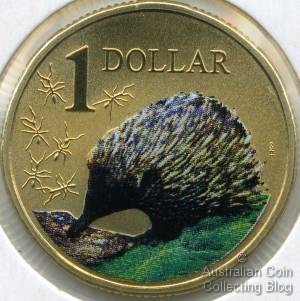
Australia 2008 pad-printed Echidna Dollar
Since 2006 the RAM has adopted a pad-printing process to decorate the reverse one dollar coins in the 06-07 Coloured Ocean series and for 2008 the Coloured Land series. These have a painted design and would stick out like a sore thumb in your change. The Land series so far includes the Koala, Wombat, Echidna and Rock Wallaby.
Getting back to collecting themes now that we know what sorts of Australian dollars are issued you can decide what you want to collect. You might want to stick to those coins only that you would find in your change. Extend that further to include 25 millimetre aluminium bronze releases that look the same as you would find in your change. Expand that again to include the mintmark variety dollars that all look the same but carry a different symbol indicating their origin. Now to make things even more difficult we could extend that to include issues where the coin is the same but the packaging is different such as in the year 2000 the NCLT Victoria Cross dollar came in an official RAM folder and also in a For Valour PNC. Beyond this (remember this is getting quite expensive now) you might choose to collect all the NCLT dollar coins that differ in size and composition to that of the circulating one dollar such as the One dollar pure silver Kangaroo series issued by the RAM each year. These coins are often specimen or proof quality and may be gold plated or similar. These examples are larger coins at 40.6 millimetre but all these NCLT issues differ.
Remember what you choose to collect is totally up to you. As long as you are happy with it that's all that matters. If you have been inspired by my post please continue to read up on storage solutions for your collection, a collection can become worthless if it's stored incorrectly.
One of the beauties of coin collecting is that there are no hard and fast rules that determine what you should and shouldn't collect. One way of collecting coins is collecting a 'type' set of coins. A type set of coins comprises an exemplary type of each coin from a series of coins. What exactly makes up a type set is open to a great deal of debate, but as I mentioned, it's your collection so you can define it.
I thought it would be worthwhile examining a series of coins to determine (loosely) what a type set for this series would comprise. I've decided to focus on the Australian Threepence, because it's a short set and not open to much debate. The Australian 3d was minted from 1910 to 1964 spanning the reign of 4 different monarchs. Edward VII had coins minted in 1910 only, George V from 1911 to 1936, George VI from 1938 to 1952, and Elizabeth II from 1953 to 1964. Of these monarchs George VI and Elizabeth II threepence were minted with two obverses. So it is (on the surface at least) very easy to define the 'type' set for the Australian 3d.
1. Edward VII 3d (1910 only)
2. George V 3d (1911-1936)
3. George VI Obverse 1 (1938 to 1948)
4. George VI Obverse 2 (1949 to 1952)
5. Elizabeth II Obverse 1 (1953 to 1954)
6. Elizabeth II Obverse 2 (1955 to 1964)
There we have it, 6 coins and you have an Australian 3d type set! Right? Well, perhaps. What if we were to take into account mint marks? From 1942 to 1944 some Australian 3d's were minted in the USA with a D (Denver) or S (San Francisco) mint mark on the reverse of the coin. In addition, in 1951 some 3d's were minted in London, again with a mint mark on the reverse (this time a PL). So now, our type set is expanded by a further three coins.
7. George VI 'D' mintmark (1942 or 1943)
8. George VI 'S' mintmark (1942 to 1944)
9. George VI 'PL' mintmark (1951)
OK, finally, we're done! Well, again, perhaps we are and perhaps we are not. This is where things get really murky. What if we were to include major varieties into the mix? The Aussie threepence has two of these, the 1922/1 overdate and the 1934/3 overdate. These two overdates are certainly in most of the dansco type folders for this series, so they could indeed be considered part of the type set. But this is where the decision lays with you, the collector. You may decide to ignore these two major varieties from your type set and concentrate on the first nine coins I've mentioned. The main reason? Cost! The 1922/1 overdate 3d in just fine condition can cost as much as acquiring a choice or gem coin of each of the first nine coins I have mentioned.
Truly the path forward is up to you, when collecting a type set. I'd suggest thinking about the following before setting on the path of type collecting.
- Define the type set you want to collect before you start. Research the series and costs of the coins you would like. It is better to know now that a set is likely to be out of reach because of cost or scarcity. Nothing kills interest quicker than lack of progress.
- Define you budget and grade of coins you want to collect. You might go for a matched grade set (say VF) or a premium set (Choice or better).
- Certain sets may give you an option in terms of strike. For example, you could easily collect post 1966 decimal coins in proof finish without having a huge outlay.
- Don't be restricted by what makes a 'type' set. You may like to collect the best grade coins issued from a certain country for a certain year. You may look for type coins with images that fit a theme that interests you (animals and military themes are popular).
- Remember, this is supposed to be fun. If it stops being fun examine what you are doing and either revise your goals or move onto something else.
The Sandpit is one of the more useful Australian numismatic websites out there. It is authored by one of Australia's foremost numismatic authorities and he is acknowledged as one of the countries leading coin graders. A particular strength of the site is the well researched articles the author has written that help collectors of Australian coins identify different varieties and forgeries.
An article of particular interest to the new collector of coins of any country is the article covering the topic of Investing in Coins. The crux of the article is to buy the best quality coins that you can, ideally the rarer the better! Another two articles that are of interest to the more advanced Australian collector are how to spot a fake 1923 halfpenny and how to spot a fake 1930 penny. These two rarities are key coins that a lot of Australian collectors seek to acquire and these articles are essential reading. There are some more informative articles on off center strikes and different varieties of half pennies and Australian dollars. You can see all of the articles on the Australian Numismatic Articles page.
It's a good site and well worth a look for the Australian coin collector. My only gripe is that new articles are slow to appear. The author is clearly an expert in the subject area and all the information he could disseminate to the community could only help improve it!
A PNC is a shortened term for a postal or philatelic and numismatic cover. This is generally a first day cover type of envelope with stamps and a postmark and then a coin inserted into the cover. Ordinarily in Australia these PNC's are issued by the Royal Australian Mint or Perth Mint in conjunction with Australia Post. Sometimes they have limited edition numbers or special limited stamps but quite often they are freely available as unlimited issues.
My concern to those not familiar with PNC's is that just recently in the last couple of years it has become "fashionable" to buy and onsell these pnc's for profit. This has brought rise to backyard operators creating their own pnc's from first day covers or simply envelopes with stamps maybe postmarked at a post office with crude holes cut for the coins.
My advice here is to research what you are buying before jumping in and bidding on items such as those on eBay. Check the mintage / issue numbers for what you are buying and check if these are in fact official releases. Don't be caught out. History has shown that in reality only one Australian private release PNC has brought profit for buyers. This is the 1969 Yarralumla PNC I have previously written about. One of the the latest releases onto the Australian market is an interesting issue from Downie's. It celebrates Australia's relationship with Denmark because of Princess Mary and contains a 2007 20 cent. Personally I don't see how this all fits together as a PNC and obviously it is not an official issue by any means, don't get caught out here.
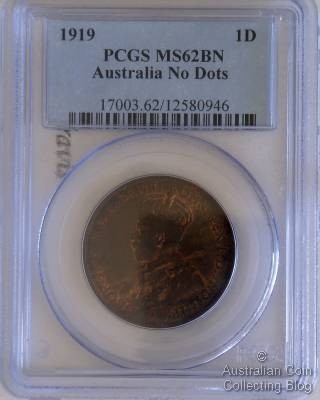
PCGS MS62 Australia Penny
The Problems with TPG's (Third Party Grading Companies)
The real problem with TPG's is that graders are still human, and the grades assigned to coins are still subject to human opinions and the grade of a coin cannot be expressed adequately with just some letters and numbers.
- The numerical grades adopted by TPG's do not inform purchasers of other factors affecting a coin value. For example, two MS64 coins may have the same numerical grade, but one may exhibit the remnants of a fingerprint, or have unattractive toning. These factors are not noted on a coin holder.
- The grade given to coins of a given series is very dependent on the experience of a grader with that coin series. Typically the TPG's are very experienced with US series and less so with world coins. This can leave non US collectors scratching their heads when getting non US coins graded.
- The numerical grading system used by TPG's does not translate directly to the adjectival grading system used in some non US countries, leading to confusion and possible deception on the part of coin sellers.
- Grades between TPG's are not the same. For example PCGS is renowned for being a tougher grader of coins than NGC. So a NGC MS64 grade does not neccesarily mean the same coin will receive the same grade in a PCGS slab.
- Grading standards change in time. For example, PCGS is currently very tough on US Morgan dollars, and many collectors acknowledge that coins graded in the 90's by PCGS would likely receive lower grades if graded today!
- The coin slabs themselves can be counterfeited leading to either incorrectly graded coins or counterfeit coins entering the market.
- The TPG's can just get it wrong. I have seen examples of Australian coins in TPG slabs listed as proofs when it is well known that no proof coins of that coin and year were ever produced.
In the final part of this series I'll draw some conclusions and provide you with some further reading.
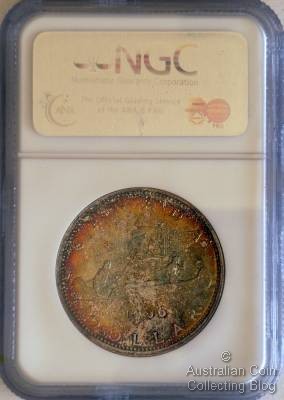
NGC MS62 Canada 1966 Voyageur Dollar
The Advantages of TPG Graded Coins
Given that a TPG is truly independent and professionally run by experienced coin graders there are definite advantages in purchasing coins graded by such companies.
- You can be more assured of the grade of a TPG graded coin.
- You can be more confident when purchasing a coin sight unseen or just on the basis of images. This is especially important in the age of the internet and online coin auctions.
- Coins are securely protected inside of the coin slabs, safe from physical and environmental damage.
- The tamper proof slabs lessen the likelihood of coin swapping by unscrupulous dealers.
- You can be more assured of the coins value on the basis of it's grade. Some of the TPG's provide price guides on the basis of coin grades.
- You can be more assured of the coins authenticity and lack of problems if it gets into a slab.
There is no doubt that TPG grading makes for a more liquid and more confident coin market. However, TPG's are not without their problems and I will discuss this further in part 4 of this series.
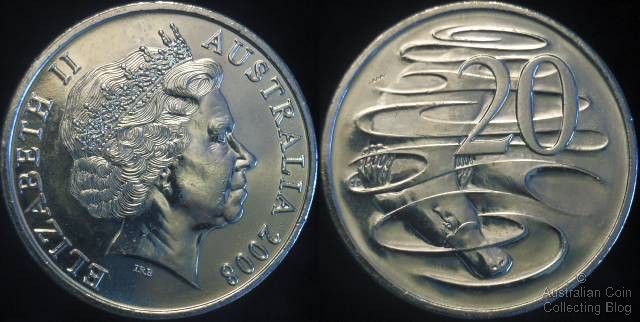
Australia 2008 20 cent
In 1963 a competition was held to design the new Australian decimal coinage that was to be introduced in 1966. The new decimal coins were to replace the predecimal coinage that had been in circulation since 1910. Six competitors vied for the honour of designing these new coins.
One of these designers was Geelong born artist and goldsmith Stuart Devlin. Devlin and the five other competitors met monthly to discuss their ideas and designs offering each other constructive criticism. Stuart Leslie Devlin couldn't go past featuring Australian native fauna on the new coins to help them be a winner with the Australian public. Stuart Devlin was announced the winner with the 1 cent coin featuring the feather-tailed glider, the 2 cent a frilled neck dragon lizard, 5 cent a spiny echidna, the 10 cent a lyrebird, the 20 cent duck billed platypus and the 50 cent Australian Coat of Arms. The kangaroo didn't leap onto a coin design (aside from the coat of arms) until the one dollar in 1984. Devlin wanted depth in his designs and the feeling of movement in the coin design. Hence the 20 cent platypus, Devlin's favourite brings the idea of looking through water at the platypus swimming into the third dimension.
In 1988 his artistry became computerized allowing him to realize his design much faster. It takes an average of a month for Devlin to design a coin, with 2 weeks spent on research and 2 weeks for the design. The design on paper must then be modified to involve depth and details and is sent to a sculptor to make a 3-D plaster model. It is then sent to the mint for approval.
Devlin, the designer who is said to have the "midas touch" now resides in England and has designed coins for over 36 countries in his career. His designs have stood the test of time, still being minted today and have been circulating for 40 odd years. It is interesting to note that very few of his designs actually carry his initials. On this Devlin states "It is satisfaction enough to know that millions of people throughout the world carry my work in their pockets."
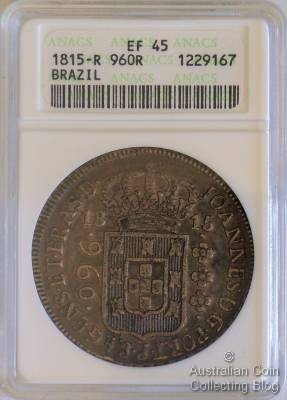
ANACS EF45 Brazil 1815 960 Reis
Third Party Grading Companies Start
To try to level the playing field the American Numismatics Association formed the first third party grading company in 1972. ANACS (the American Numismatic Association Certification Service) offered to grade and authenticate coins on an impartial and fee for service basis and return them to collectors. The aim of ANACS was to provide collectors a service that would grade and authenticate a coin completely independently without any bias. This would help bring confidence to the coin market and allow for less conflict and trouble in the buying sight unseen coin market.
Since the founding of ANACS many more TPG's have been founded. Currently PCGS (Professional Coin Grading Service) sit at the top of the TPG heap, with NGC (Numismatic Guarantee Corporation) and ANACS being excellent but less well regarded grading companies. The major US grading services will grade and authenticate coins for collectors and if a coin is found to be genuine and not a problem coin they will return the coin in a 'slab'. A slab is a sonically sealed plastic holder for the coin that includes a label with the coins type and grade.
There are third party grading companies in other countries (such as the Canadian Coin Grading Service and Coin Grading Australia) but these generally do not currently supply coins in tamper proof slabs. This leads to possible coin swapping and fraud on the behalf of coin sellers. They do have some advantages though, as they may be better at grading their local coins than the major TPG's in the US. This is simply because they have more experience with the local currency, the nuances of each denomination in terms of strike quality from year to year and so on.
In the next part of this series I'll cover some of the advantages of using third party grading companies.
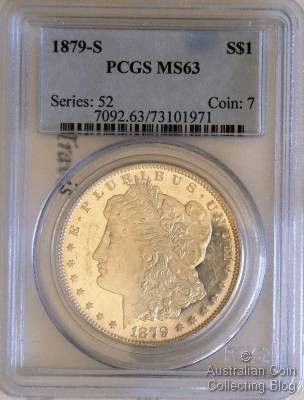
PCGS MS63 1879S Morgan Dollar
Coin Grading, a difficult problem
Grading coins is a very subjective topic. The grade of a coin depends not only the amount of wear of a coin, but also the quality of the strike, bag marks, luster, eye appeal, rim condition, and many other factors. Very few of these factors can be easily quantified on any measurable scale, and even when trying to do so each factor is subjective and can vary depending on who is grading a coin. Thus, any single coin can be assigned a different grade when given to different coin graders. It can vary depending on experience of the grader, the type of coin being graded, how 'tough' a person happens to be grading a coin, or even the day of the week.
Of course, the actual grade of a coin is critical, with the same graded almost uncirculated versus uncirculated potentially having values 100's or 1000's of dollars different. The potential conflicts in grading a coin become even worse when buying and selling coins. It is natural for sellers to tend to over grade a coin to get more money, and buyers to under grade coins to get them cheaper. Particularly unscrupulous sellers will go out of their way to over-grade coins to dupe novice coin collectors who are unable to grade coins. Even worse is when counterfeit or cleaned or altered coins are passed off as genuine or non problem coins. Clearly this is a problem that needed a solution.
In part 2 of this series I'll cover the origins of the third party grading companies.
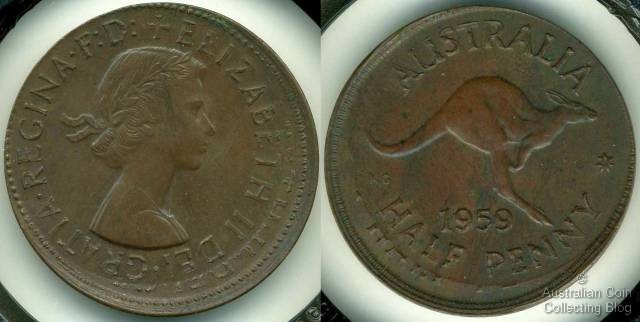
Double Struck 1959 Half Penny
An interesting class of coin error is the double struck coin. This type of error occurs when a minted coin is struck again by the coining dies before it has left the coining press completely. This usually results in a partial impression of the coin over the previously struck image. For example, the image above shows a double struck Australian 1959 half penny. On the obverse you can see the remnants of the first strike showing from about 12 o'clock to about 7 o'clock in the area close to the rim. On the reverse you can see the remnants of the first strike from about 4 o'clock to 11 o'clock, again in the area close to the rim.
Below we can see a decimal double strike on a two dollar coin, quite a rare occurance to see one this spectacular. An example like this would probably set you back $1000+
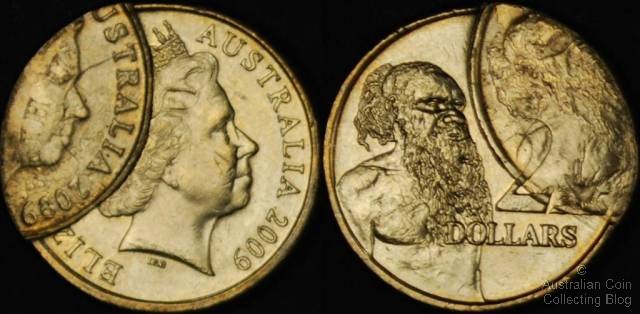
Double Struck 2009 $2
A coin can be struck more than twice, examples do exist of triple and quadruple struck (and even more) coins. It is also interesting to note that modern day proof coins are often struck more than once to give better quality and depth of strike. But of course the coins do not move between strikings so you do not see multiple images of the coins.
My last entry about the Australian 2000 $1 / 10 cent mule and the recent discovery of a new 20p mule in the United Kingdom made me realize I hadn't actually done an entry on the so called mule error. Put simply, a mule error coin is a coin that is minted using an obverse die and a reverse die that were never actually intended to be used on the same coin. The most well known mules in world coin collecting are the New Zealand 2c / Bahamas 5c mule, the United States Sacagawea $1 / Washington Quarter mule, and the Australian 2000 $1 / 10c mule.
What actually makes a coin a mule is subject to some debate. The above examples I gave are undoubtedly mules. The obverse and reverse dies of these coins were never ever intended to be used together. For example, the New Zealand reverse die / Bahamas obverse 2c die are from totally different countries and were never intended to be used together in any event. The same applies for the Sac Dollar and Washington Quarter dies, and the Australian $1 and 10c dies. However, a grey area rises when dies of the same denomination are used in combinations that may be normal in some years but not in others.
There are examples in the Australian coin collecting area that are subject to heated debate. An example of this is the 1956y Penny 'mule'. In this case, the normal Perth mint reverse die was used (in error perhaps) with a Melbourne mint obverse die. This is unusual, but pennies were minted in Melbourne and Perth in 1956 so some collectors argue that this coin is not in fact a mule, just a variety of the 1956Y penny.
Another example is the 2005 $1 mob of roos coin. Some collectors believe that this coin was actually minted in error (the standard $1 coin of this year was a 50th Anniversary of WW2 dollar) by the Royal Australian Mint. They believe that to cover up this error the mint simply kept producing the 2005 $1 mob of roos coin and released millions into circulation. While most sensible collectors dont call this coin a mule, there are people (usually wanting to make money on ebay) who call the 2005 $1 mob of roos coin a mule!
Whatever makes an error coin a mule, they are interesting coins to collect. And when struck from dies of different denominations from the same country, or from completely different countries they are indeed spectacular coins to look for and own.
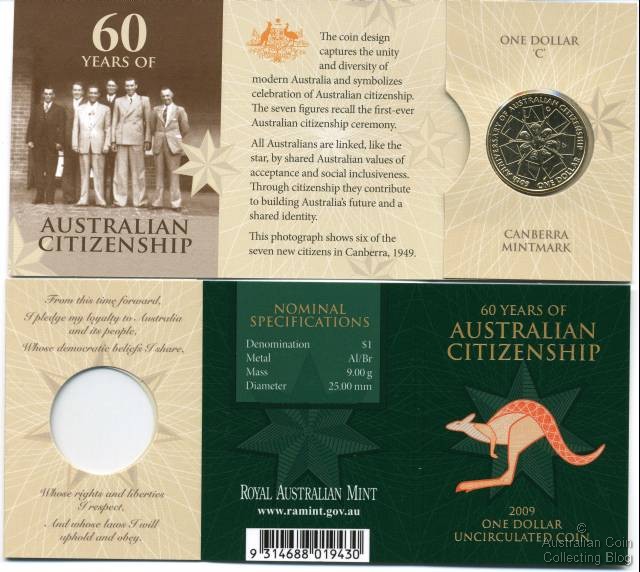
Australia 2009 Citizenship $1
The 1st January 2009 brought a change in the commemorative dollar design for the one dollar coin in Australia. Aside from the regular circulation mob of roo's design for our $1 there are often other releases to commemorate special events. For 2009 the theme is 60 years of Australian Citizenship. In 1948 the Australian Citizenship Act came into effect and to date more than 4 million people from various backgrounds have taken part in the affirmation ceremony to become Australian citizens. It is their chance to share a sense of belonging to Australia and make a commitment to our values and help to build Australia a strong future (they also get to vote and have an Aussie passport).
Each year the public line up on the Royal Australian Mint doorsteps to become the first people in the world to mint their own coin for the new year. This year the coin design features seven smiling new Australians with their hands raised linked in design forming the federation star. Amongst mint visitors in the line-up awaiting the mint's opening were overseas visitors, holidaying Australians, collectors and curious visitors, many men, women and kids running around.
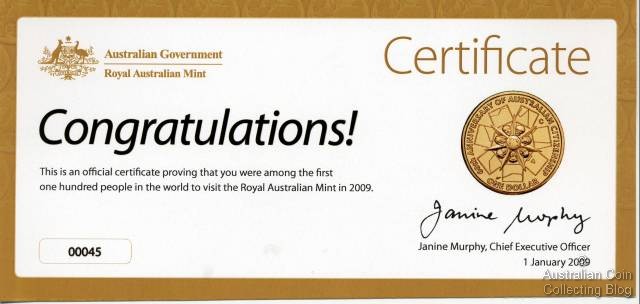
2009 First 100 Visitors To Royal Australian Mint Certificate
When the mint opened at 10am people entered the building and the first one hundred visitors were given a special numbered certificate commemorating their visit to the RAM. This certificate is shown above. After a speech from the Deputy Chief Executive Officer Mr Graham Smith and a photo by an Australian Immigration Department photographer visitors were allowed to enter the press gallery in their numbered order. They then fed $3 into coin operated gallery presses, pressed a button and watched their newly created coin being struck. If you were really tricky the mint staff and also the Acting CEO were happy to autograph the coin folder. A very busy morning for the Royal Australian Mint but well worth the effort to attend.


